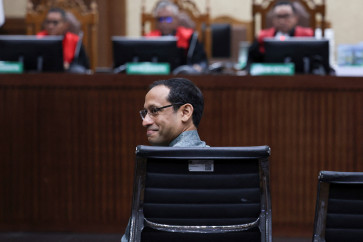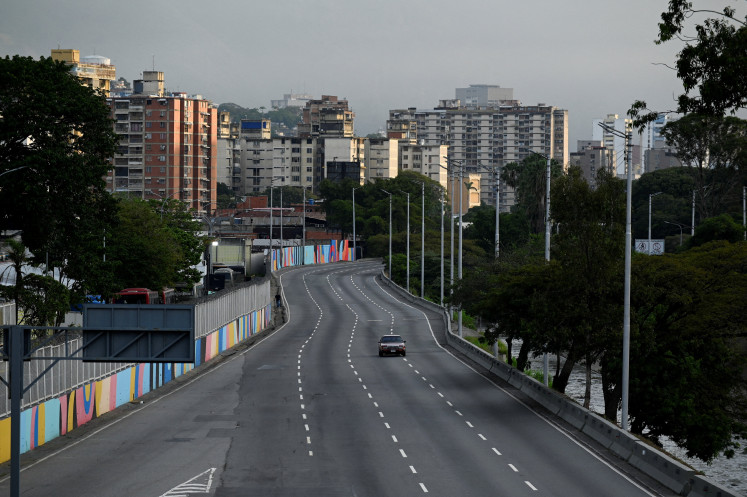Popular Reads
Top Results
Can't find what you're looking for?
View all search resultsPopular Reads
Top Results
Can't find what you're looking for?
View all search resultsBlitar’s ancient Gedog temple & banyan trees hold mysteries
Time capsule: Ancient carvings of women at Gedog temple in Blitar, East Java
Change text size
Gift Premium Articles
to Anyone
Time capsule: Ancient carvings of women at Gedog temple in Blitar, East Java.
A magnificent specimen of banyan sits just outside Blitar in East Java, colonizing almost 100 square meters of the surrounding land. It may have started growing during the Dutch ascendancy in the region. If so, the invaders may have noted nature’s expansion as a mirror of their own across the archipelago.
One of the tree’s relatives in India is reported to be more than 550 years old. The tree in Blitar has thrived not only by living in fecund fields but also because the water table is only a few meters below ground, easily visible in a large hole.
That hole has been excavated behind a small cluster of graves, so close that only a brick wall protects the remains of Yohanes Sunyoto from the elements. His headstone has no date but we know his religion because the tiles form a symbol.
This was a Christian cemetery used since the time of Raffles’ sojourn in Java.
Five of the eight graves, including two belonging to children, have been vandalized. The crucifixes have been removed, leaving jagged stumps of concrete.
Muslim burial grounds favor frangipani and there are none nearby. Hinduism used to be the dominant religion in this area until the mid-16th century.
There is also a square wellhead. It appears to be recent and suggests communal use, though the fact it was dug among graves raises the specter of contamination.
If this banyan were in a city park, it would be a regular hangout, though only during the day. When the sun sinks, the spirits appear. Even the most rational mind can’t help but imagine ghosts among the entangled roots.
In the Sanskrit epic the Bhagavad Gita, Krishna, the god of compassion and love says, “One who knows this tree is the knower of the ‘Vedas’ [Hindu scriptures].”
Yomano, a police officer, patrols the site. The holster of his sidearm brims with bullets, ready to gun down grave robbers. One tomb has already been pillaged, though many years ago.
He does not appear overstressed guarding what could be another gem in the national treasure house, though only if archaeologists can prove this is the site of a temple recorded by Sir Stamford Raffles, the British Lieutenant-Governor of the Dutch East Indies between 1811 and 1816 and later the founder of Singapore.
Raffles was a true Renaissance man — curious, adventurous and a great admirer of the Javanese. In his magisterial History of Java, he counters Dutch claims of idleness, “They are as industrious and laborious as any people could be expected to be.”
His wife Olivia died in late 1814, aged 43, and was buried in Bogor under the inscription, “Tho fate severe hath bid us part, yet still forget me not.”
Left in ruins: Vandalized graves lie without crucifixes at Gedog temple.To ease his grief, Raffles turned to travel.
In 1815, he visited Blitar. He was led to monuments smothered by jungle and ignored by the Dutch.
One was the candi (temple) of Gedog. He described the candi as a structure of brick but executed with superior craftsmanship. Much of the ornamental work was done in stone. Several of the sides were still intact but the base of the entrance had gradually separated. There is no mention of a banyan tree in Raffles’ accounts.
About a century later, on May 19, 1919, the nearby Mount Kelud erupted causing great damage around Blitar. This event may have shaken down the temple.
Mt. Kelud is small (1,731 meters) but brutal, infamous for its short eruptions and destructive flows of molten rock. Along with Merapi, north of Yogyakarta, Kelud is considered the most dangerous of Indonesia’s 127 volcanoes.
Kelud is estimated to have taken more than 15,000 lives in the past 500 years but has also enriched the Blitar rice plains with volcanic ash.
After Raffles left and Java returned to Dutch control, the colonialists started showing an interest in antiquities. This led to the plunder of many sites and the export of statues. Even now, there are reports of ancient bricks on the market, although their sale is illegal.
Locals have been finding so many scattered carved stones in Gedog that, last year, the Cultural Heritage Preservation Center got interested. The organization is based in Trowulan, 90 kilometers north of Blitar and the capital of the Majapahit Kingdom (1293 – 1527).
Archaeologists were sent to Gedog to dig around and collect artifacts that may well have been from that golden era. The objects are now stored in glass cases near the banyan but are unlabeled, meaning amateurs have no idea of their provenance.
Two saber-toothed, goggle-eyed statues of kala (a manifestation of the Hindu god of the underworld, Yama) are now cemented onto blocks to deter looters. These fearsome faces are often found on the lintels of East Javan temple gates.
Atop one small kala is a garish plastic cup holding a couple of joss sticks, suggesting that ancient beliefs still thrive.
The presence of village public security officers, high fencing, lighting, a red and white tent and some do-not-cross yellow tape suggests authorities are now taking the preservation of the nation’s past seriously.
The UNESCO has nine World Heritage Sites in Indonesia with 20 more on a “tentative” list.
Hilmar Farid, the Education and Culture Ministry’s culture director general, has said heritage sites should be preserved to offset the image that Indonesia is all about development and modernization.
Fine words, but sadly, they are not well rooted like the banyan. The police eventually got bored and left, saying locals would keep an eye on the site. There were no other visitors.
There is a big gap in the fence so thieves wouldn’t need to sneak — just stride in, smash and grab a few carved stones then sell their nation’s precious heritage.
On patrol: Yomano, a police officer, examines ancient kala statues.— Photos by Erlinawati Graham












